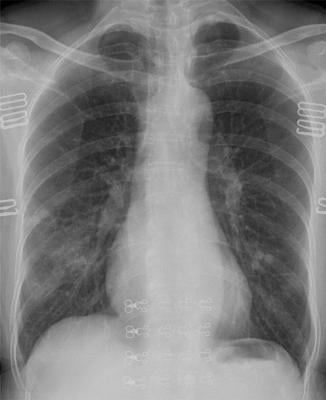
Chest radiograph in a patient with COVID-19 infection demonstrates right infrahilar airspace opacities. Image courtesy of Radiology: Cardiothoracic Imaging
March 6, 2020 — While COVID-19, previously known as the novel coronavirus, was first reported in China, it was recently declared a global health emergency by the World Health Organization. Because most cases have been in China, clinicians elsewhere may be unfamiliar with how the virus appears in the lungs.
And reports are now showing the importance of computed tomography (CT) in diagnosis and monitoring of the infection.
“As COVID-19 continues to evolve on a global scale, it is important for radiologists to be familiar with the imaging appearance of the virus in patients,” said Prachi Agarwal, MBBS, M.D., a professor of radiology at Michigan Medicine. “Radiologic work here is extremely crucial when it comes to making diagnoses for patients.”
This inspired Agarwal to team up with Weifang Kong, M.D., a radiologist at Sichuan Provincial People’s Hospital in Chengdu, China, to examine the appearance of COVID-19 in three separate case studies involving patients with the condition.
Their research was recently published in Radiology: Cardiothoracic Imaging.
“Our work focused on the imaging appearance of COVID-19,” said Agarwal. “The radiographic and CT appearance is not specific to the disease and can be seen with other infections, too.”
The pair discovered that while the imaging appearance of COVID-19 is not specific, the presence of bilateral nodular and peripheral ground glass opacities and consolidation should serve as an alert to radiologists that COVID-19 may actually be present in certain patients.
For example, individuals who have a defined travel history to areas where others are infected by COVID-19, or have been directly exposed to others with the virus, should be examined carefully.
Agarwal adds that in radiologic terms, ‘ground glass’ means that a hazy lung opacity shows up on imaging that is not dense enough to obscure any underlying pulmonary vessels or bronchial walls. While consolidation, on the other hand, refers to dense opacities obscuring vessels and bronchial walls.
Since ground glass opacities are common in COVID-19, Agarwal notes that chest CT scans are preferred over chest radiographs, which may have limited sensitivity in picking up early changes within the lungs.
“Chest CT scans can be helpful in suggesting the diagnosis for a patient and also, for monitoring patient responses,” said Agarwal. “It’s important to note that there is a spectrum of clinical manifestations and clinical course in COVID-19. And the clinical presentation of the virus can overlap with other respiratory illnesses.”
Some patients who tested positive for COVID-19 were either asymptomatic or had minimal symptoms. And while the reference standard for making the diagnosis is a real-time reverse transcription polymerase chain reaction (RT-PCR) test, false negative results can occur.
“It has been shown that an abnormal chest CT scan can predate a positive RT-PCR, highlighting the important role of CT in the management of these patients,” said Agarwal.
To learn more about COVID-19, visit: What Can You Do to Protect Against Coronavirus?
Additional COVID-19 Resources for Clinicians:
World Health Organization (WHO) COVID-19 situation reports
World Health Organization (WHO) coronavirus information page
U.S. Food and Drug Administration (FDA) COVID-19 information page
Centers for Disease Control (CDC) COVID-19 information page
RELATED CORONAVIRUS CONTENT:
The Cardiac Implications of Novel Coronavirus
CT Provides Best Diagnosis for Novel Coronavirus (COVID-19)
Radiology Lessons for Coronavirus From the SARS and MERS Epidemics
Deployment of Health IT in China’s Fight Against the COVID-19 Epidemic
Emerging Technologies Proving Value in Chinese Coronavirus Fight
Radiologists Describe Coronavirus CT Imaging Features
Coronavirus Update from the FDA
CT Imaging of the 2019 Novel Coronavirus (2019-nCoV) Pneumonia
CT Imaging Features of 2019 Novel Coronavirus (2019-nCoV)
Chest CT Findings of Patients Infected With Novel Coronavirus 2019-nCoV Pneumonia


 December 10, 2025
December 10, 2025 









